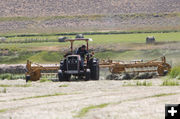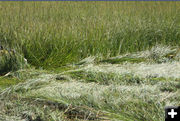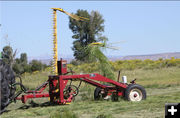
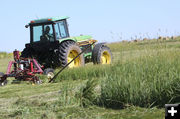
Mowing
Putting the cutting bar down to mow.
|

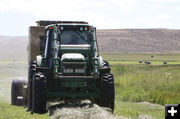
Baling
Baler moving down windrow picking up the hay and making it into bales.
|

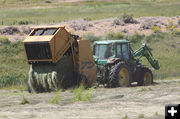
Done bale
Finished bale coming out from baler.
|

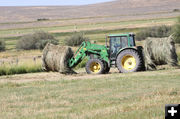
Two bales
Bringing in two bales to the hay corral.
|
|
Haying
by Jonita Sommers - Rancher Talk
September 7, 2010
Roaring of motors in August is a common sound in the hay fields of the Green River Valley. Tractors moving in the hay fields around the hay stack are like ants busy at work around their ant hill. Green grass turning different shades of green as the hay is cut, baled and stacked is a typical site on Green River Valley ranches.
August is haying time in the Green River Valley. Some people start the latter part of July and some end the haying operation in September, but the bulk of the hay is put up in August.
Haying began in the Green River Valley earnestly after the "Equalizer Winter" of 1889-90 when ninety percent of the cattle died because the snow and ice was so deep the cattle could not get to feed and no hay had been put up to supplement them. A few ranchers put up a little hay for the horses and milk cows kept in the corrals, but nothing to save the herds.
Now, every ranch, which winters cattle, puts up hay to feed those cattle in the winter. When the ranchers first started putting up hay it was put up in loose hay stacks like Campbells still do in the Hoback Basin. The early ranchers stacked the hay with nets and dropped the hay on the stack. The overshot stacker soon became the fashion where the hay was more or less thrown onto the stack with a big wooden fork like a catapult. The beaver slide with the plunger to push the hay up the slide to the stack was the third way hay was put in the stack. Balers came into fashion in the 1950s and 1960s in the Green River Valley. They really became part of the haying operation in the United States in the 1940s. However, many people still stacked loose hay. The big square and round balers were developed. The first round baler did not see production until 1947, when Allis-Chalmers introduced the Roto-Baler and it ended in 1960. The next major innovation came in 1972, when the Vermeer Company began selling the first modern round baler. Previously, round hay bales had been little more than lumps of grass tied together, but the Vermeer design used belts to compact hay into a cylindrical shape as is seen today. In 1978, Hesston developed the first 4X4 square baler of its kind. By the 21st Century, only one family in the area still stacked loosed hay. You mostly see big round bales today.
The hay has to be mowed down with a sickle or drum mower or a swather. Once the hay is cut it has to "cure," to reduce the moisture level, so it will not mold or ignite into a fire when it is baled and stacked. "Cured" hay needs to have very little moisture and the stems snap when bent by the hands of a rancher. It usually takes about 1 to 2 days for the hay lying on the ground to be cured enough to be baled in the Green River Valley. The humidity and wind play a large role in how the hay cures.
The ranchers do not want it to rain on the hay because the rain can cause the hay to lose its protein and reduce the feed value. The ranchers want to put the hay up so it will has as much protein value as possible but will not mold because it is too wet.
Once the hay is "cured," it is raked and a baler goes down the windrow of hay. The balers have computers today telling when the bale is the correct size. Balers tie the bales with plastic twine or sisal twine. Sisal is a natural fiber that naturally decays over time.
After the hay is baled, it is stacked in hay corrals or stack yards so the cattle cannot eat it until the rancher is ready to feed them.
Watching for the songbirds and swamp birds so they can be chased out of the way is a fun part of haying. The hawks are awesome. The hawks love haying and it is especially important for the young hawks. The hawks follow along behind and rake or baler and watch for mice.
Once a mouse is spotted the hawk dives for its prey. When haying starts, you know summer is about over and fall is soon to follow. Soon the hay will have to be fed to the cows during the winter months.
Photos courtesy Jonita Sommers
|

